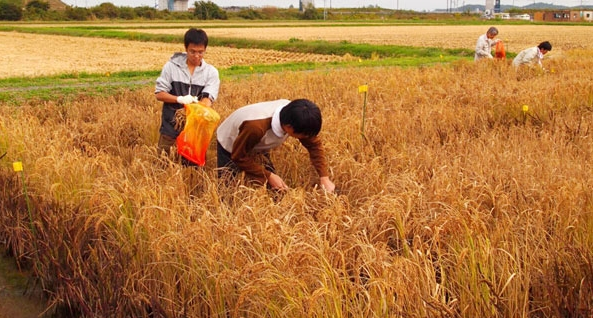(单词翻译:单击)

Science and technology.
科技。
Salt-tolerant rice.
耐盐大米。
Nuclear-powered crops.
核动力粮食。
Physics meets biology in a project to breed better strains of rice.
物理学与生物学的碰撞--优质大米培植。
THOSE who turn their noses up at "genetically modified" food seldom seem to consider that all crops are genetically modified. The difference between a wild plant and one that serves some human end is a lot of selective breeding-the picking and combining over the years of mutations that result in bigger seeds, tastier fruit or whatever else is required.
对转基因食物不屑一顾的人似乎忽视了一个事实:所有粮食都属于转基因食物。野生植物与供人食用的植物之间的不同之处在于后者经过了层层筛选和培植,也就是经过多年的突变,将优良品相进行选择并组合,以培育出更大的种子,更甜的果实,或者人类需要的其他结果。
Nor, these days, are those mutations there by accident. They are, rather, deliberately induced, usually by exposing seeds to radiation. And that is exactly what Tomoko Abe and her colleagues at the Riken Nishina Centre for Accelerator-Based Science in Saitama, outside Tokyo, are doing with rice. The difference is that Dr Abe is not using namby-pamby X-rays and gamma rays to mutate her crop, as is the way in most other countries. Instead she is sticking them in a particle accelerator and bombarding them with heavy ions-large atoms that have been stripped down to their nuclei by the removal of their electrons. This produces between ten and 100 times as many mutations as the traditional method, and thus increases the chances of blundering across some useful ones.
这些年的变异并非自然发生,而是常常通过将种子暴露于辐射下等方式引导发生的。阿部知子和她的同事就在进行这一工作以培育大米。他们的工作地点位于东京外部的埼玉县仁科加速器研究中心。不同之处在于他们没有像其他国家一样,利用纤弱的X射线和伽马射线来引发变异。他们将种子放入粒子加速器,并用重离子对种子进行轰击碰撞。重离子是大原子去掉电子后只剩原子核的状态。这一方法比辐射法的效果好十到一百倍,并且有用的种子不易被忽略掉。
Dr Abe's plan is to use these mutations to create salt-tolerant rice. She has tried to do that several times in the past, but the result did not taste very nice. Her latest effort was stimulated by the flooding with seawater of almost 24,000 hectares of farmland by the tsunami which followed an earthquake in March last year. Salt-tolerant rice would, though, be of much wider use than just restoring the paddies of Miyagi prefecture and its neighbours, the worst-affected part of the country, to full productivity. About a third of the world's rice paddies have salt problems, and yields in such briny fields may be half what they would be if the water in them were fresh.
阿部知子博士计划利用变异制造出耐盐的大米。她已经尝试了多次,但结果不尽如人意。最近的一次尝试是由于去年三月地震引起的海啸冲过了近两万四千公顷农田。耐盐大米的作用不仅仅是还原日本受伤害最大的宫城县内和附近的稻田。全球三分之一的稻田都受到盐的影响,此类稻田的收成仅为正常稻田的一半。
To induce the mutations, Dr Abe bombarded germinating seeds with carbon ions for 30 seconds. She then planted them in fields in Miyagi. Of 600 seeds that have undergone this treatment, 250 thrived and themselves produced healthy seeds.
为了引发变异,阿部知子博士用碳离子轰击发芽的种子30秒,然后将其种入宫城县稻田中。在进行了上述实验的600粒种子中,有250粒成活并产出了健康的种子。
The next stage of the project, to be carried out this month, is to take 50 grains from each of the successful plants and repeat the process with them. The resulting specimens will then be sorted and the best (ie, those that have flourished in the saline soils of Miyagi's paddies) selected for crossbreeding, in order to concentrate desirable mutations into reproducible lines of plants.
本周即将进行这一计划的下一步骤,用50粒成活的种子重复进行上述实验,再将产出的种子分类。为了使种子变异充分,并且适于种植生产,在宫城县盐地生长得最好的部分将再进行杂交培育。
The result, Dr Abe hopes, will be a viable salt-tolerant strain that is ready for market within four years. With luck, this time, it will be a tasty one as well.
阿部知子博士希望能在四年内培育出市场需要的耐盐大米,幸运的话这一次的大米将会香甜可口。


